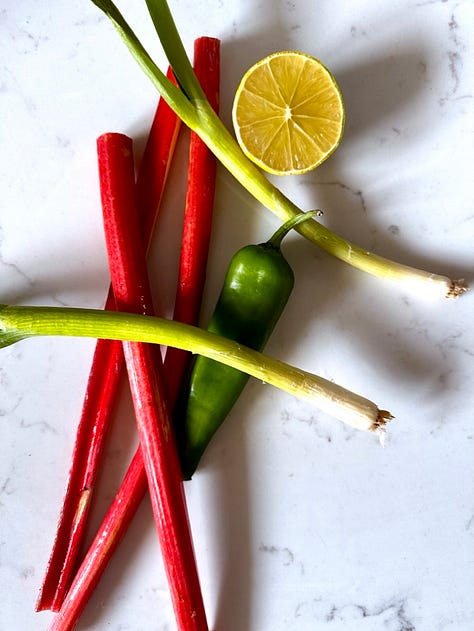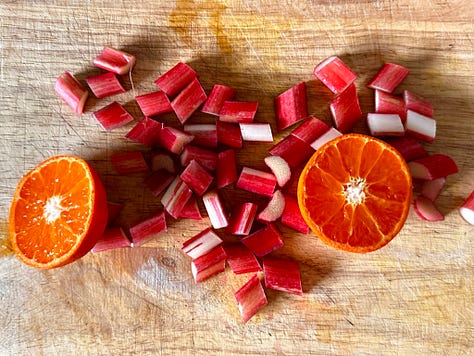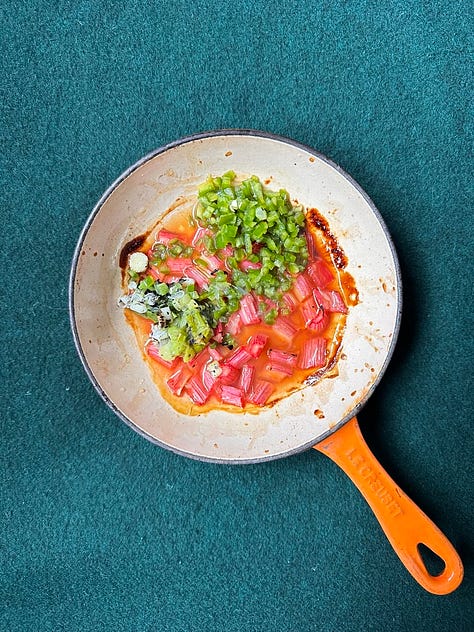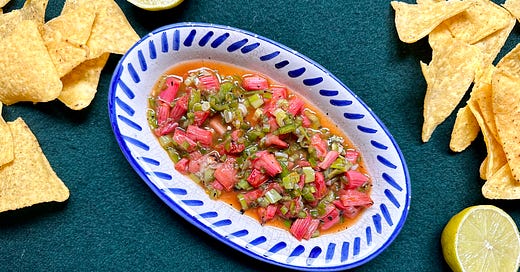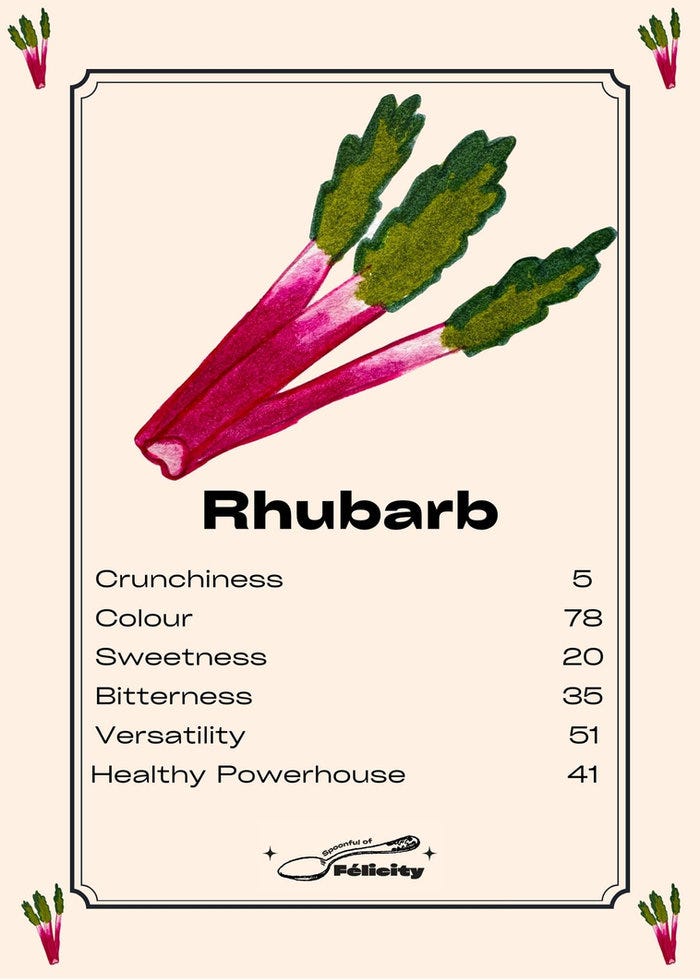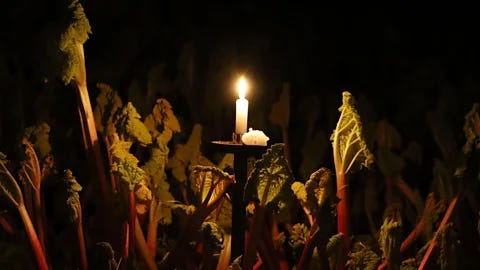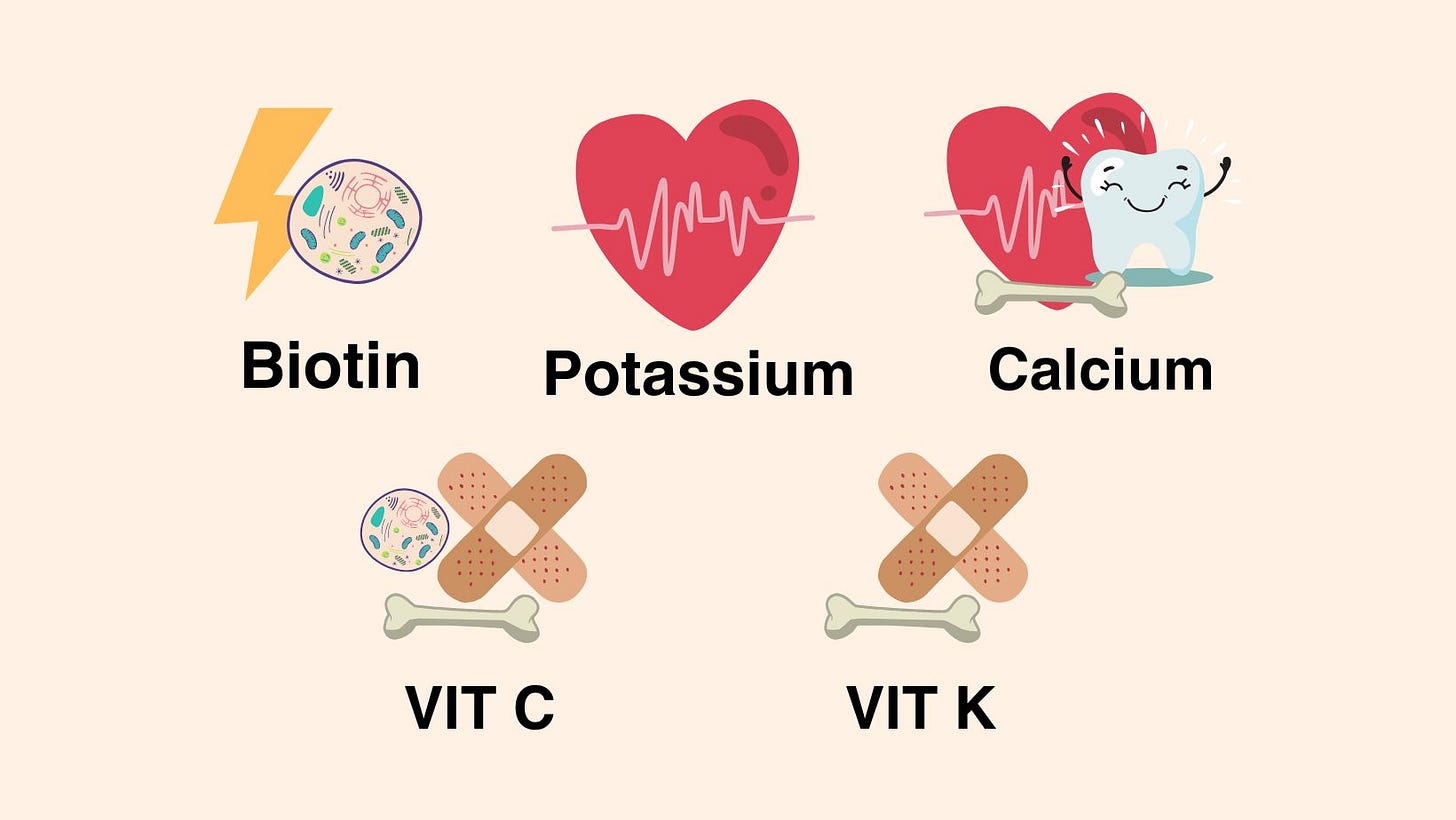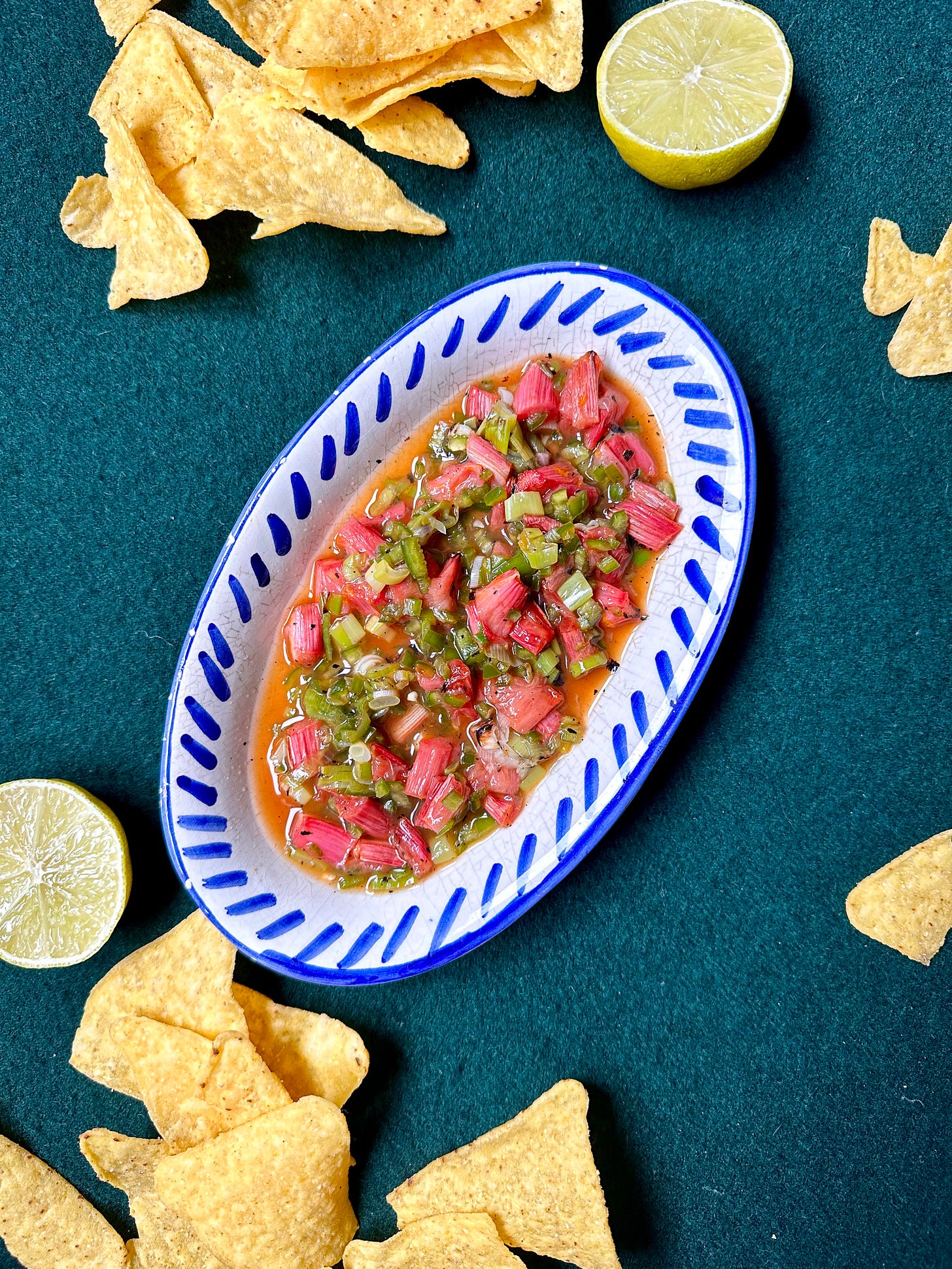March #3 - Forced rhubarb and a fun salsa recipe
A history of health benefits and a beautiful colour to bring in the Spring.
It seems everyone is talking about rhubarb this week but I’m hoping you’ll still learn something new and interesting here.
I didn’t actually start liking rhubarb until about a year ago but it was forced rhubarb roasted in the oven with sugar which completely changed my mind. Now I understand why my Granma always went on about covering rhubarb plants with a pot!
Are you love or hate?
HISTORY:
Rhubarb likely originates from Siberia and was first used as traditional medicine in Russia and China over 5000 years ago (2800BC). The first traces of its culinary use are from the late 18th century as an alternative to gooseberries in pie fillings. There were some attempts at eating Rhubarb before then but sadly people initially thought the poisonous leaves looked like tasty greens.
Rhubarb being an expensive and highly prescribed medicinal plant, it was grown in the medicinal Chelsea Physic Gardens. The story goes that in the 19th Century a worker accidentally covered a rhubarb plant in soil and noticed a few weeks later that it had grown faster with more tender and sweeter sticks. There forced rhubarb was born! Production reached its peak in Yorkshire where, along with cold weather and soil type, the proximity to coal mines allowed for cheaper heating of special sheds. The area became known as the Rhubarb Triangle, but sadly the 200 growers of the 20th Century have been reduced to only 12. They are becoming popular again though, famous for their candlelight harvesting, bright pink sticks and traditional box packaging.
FUN FACTS:
Most often it seems that our culinary vegetables are technically fruit, so it’s nice for the shoe to finally be on the other foot as this typical dessert addition is indeed actually a vegetable.
The name derives from the latin rhabarbarum, meaning a barbarian from Rha (now known as the river Volga in Russia), where trade originally came from.
Until the late 18th Century, rhubarb was only consumed as a dried powder for its laxative effects. Research actually supports this traditional medicine claim, as rhubarb contains anthraquinone. These compounds have been linked to anti-viral properties and promoting the immune system, but also, when consumed in enough quantities, it is able to reach the lower intestine and act as a laxative. It’s worth noting that rhubarb is also high in fibre to support this effect.
Not so fun fact. During World War I rationing, rhubarb leaves were recommended as a food source in Britain which led to many instances of poisoning.
HOW TO COOK THEM:
Raw: Always remove the leaves.
Pickle them: Cut the sticks into inch size pieces, put them in a sterilised jar and top with a 2:1 ratio of vinegar and boiling water + 1 Tbs of sugar, salt and spices of choice.
Make an infused gin/alcohol: Slice and cover in sugar (about 40% of the rhubarb weight), store for a day until the water from the rhubarb has been absorbed by the sugar and it has turned into syrup. Place in a sterilised jar and cover with your alcohol of choice to infuse for at least 2 weeks.
Cooked:
Add rhubarb pieces when roasting meat, especially pork.
Stewed rhubarb: slice the stalks and simmer in a saucepan with the juice of 1 orange and 20% of the rhubarb weight in sugar.
Roast in the oven instead if you would like the stewed rhubarb to keep its shape.
Use stewed rhubarb on top of yogurt, porridge, or soft cheese on toast.
Top stewed rhubarb with pastry or crumble and vanilla custard.
Use rhubarb stick in cakes and biscuits for a sour inclusion to balance out sweetness.
Make cordials for soft drinks and mocktails: leave diced rhubarb and sugar overnight and collect the syrup that will have been created. Cook the remaining pieces of rhubarb to use as a compote.
Forced rhubarb pairs particularly well with vanilla, oranges, strawberries, apples, elderflower, ginger, rose, tinned lychees, creamy dairy, beetroot, pork and oily fish.
My rhubarb recipes:
Rhubarb & Jalapeño Salsa (see below)


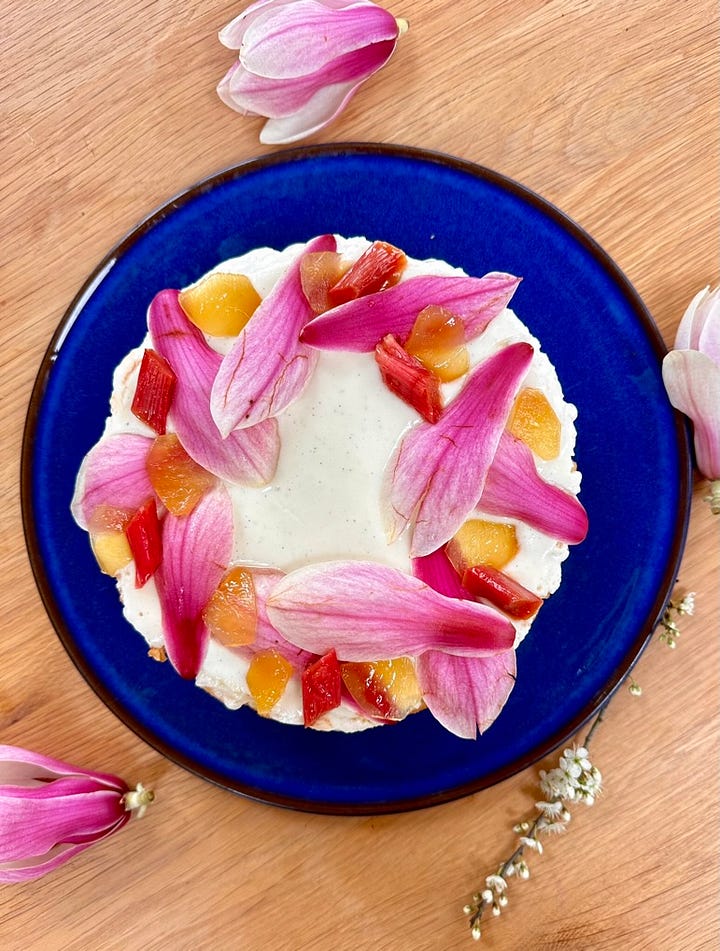
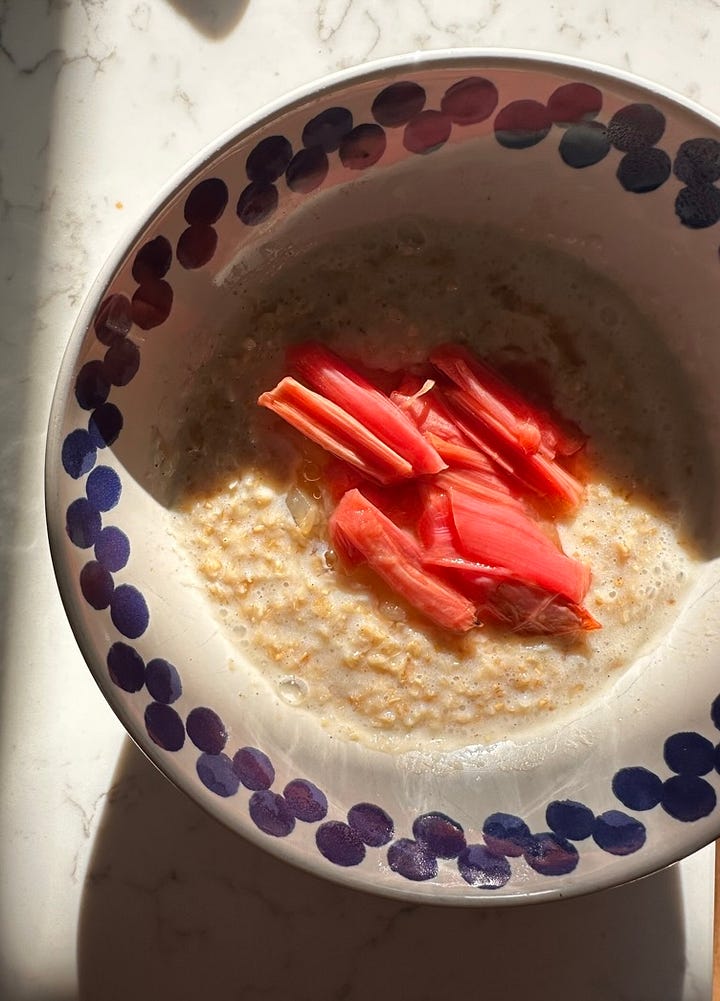
MOOD FOOD - HAPPY:
Rhubarb supports our mental well-being, not only through its deliciousness in pies, crumbles and yogurt, but also through the role of its active compounds:
anthocyanins act on our dopamine receptors, inhibiting dopamine breakdown,
calcium is utilised in the conversion of tryptophan to serotonin,
vitamin K is required for the synthesis of sphingolipids, specific structural lipids which play an essential role in brain cell function,
fibre supports our gut health, and a happy gut means a happier brain.
This week’s recipe:
Rhubarb & Jalapeño Salsa Recipe
A seasonal twist on a classic tomato salsa.
Vibrant, tangy and spicy rhubarb salsa recipe with jalapeño and lime.
Ingredients (2 portions):
Rhubarb, jalapeño and lime salsa recipe:
3 rhubarb sticks
1 orange
2 tsp sugar
1 jalapeño (or green chilli)
2 spring onion
Sea salt
Method:
Preheat the oven at 180°C.
Wash the rhubarb sticks and slice them into small 5cm cubes.
Place the rhubarb in an oven proof dish with the juice from 1 orange, 2 tsp of caster sugar and a pinch of sea salt. Roast in the oven for 20 minutes then leave to cool down.
Burn the spring onions: place them on an open flame (bbq / gas hob) or in a very hot pan and flip occasionally until the outer skin is burnt all over. Leave them to cool down under a cover, then peel off the burnt skin.
Roughly chop the spring onion into small pieces.
Remove the jalapeño seeds and dice into tiny cubes.
Mix the rhubarb (and its cooking juices) with the spring onion, jalapeño and the juice from 1 lime. Add salt, stir and taste to adjust seasoning if needed.
Serve with tortilla chips and a refreshing drink then dig in, bon appétit!
As always, if you have any questions about method, substitutes etc. feel free to send me a message!
